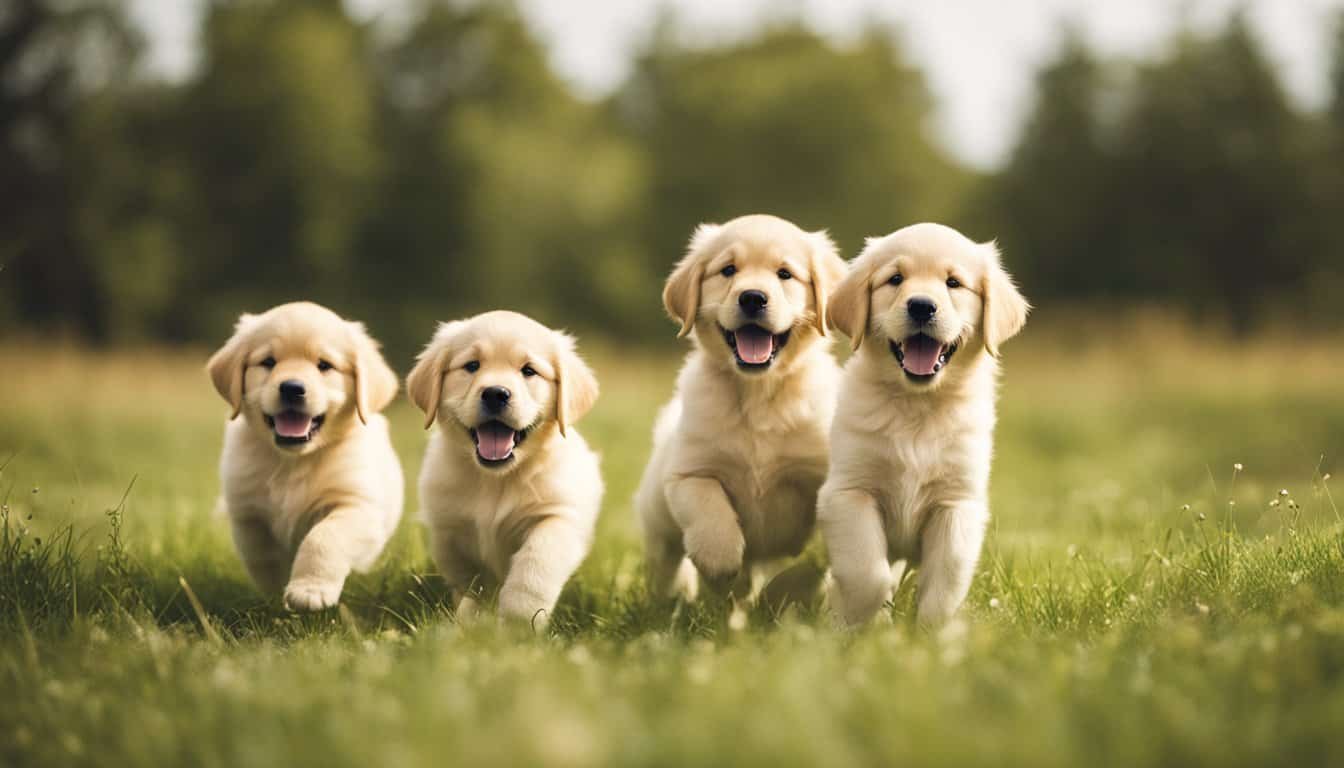If you’re considering getting a Golden Retriever, or you already have one, you might be wondering at what age they are fully grown. Knowing the answer to this question is important for understanding how to care for your furry friend. In general, Golden Retrievers are considered fully grown when they reach one to two years of age. However, there are several factors that can impact their growth and development.

Understanding Golden Retriever Growth is crucial for ensuring that your pup grows up healthy and happy. During their first year of life, Golden Retriever puppies develop gradually. By the time they reach maturity, their coat and major bodily functions have already fully grown. However, it’s important to note that growth is not linear for any breed of dog but instead occurs in spurts throughout their first 24 months of life.
Key Takeaways
- Golden Retrievers are considered fully grown when they reach one to two years of age.
- During their first year of life, Golden Retriever puppies develop gradually.
- Growth is not linear for any breed of dog but instead occurs in spurts throughout their first 24 months of life.
Understanding Golden Retriever Growth
https://www.youtube.com/watch?v=jQkbdSQ1AUc&embed=true
Golden Retrievers are a popular breed of dog and are known for their friendly, outgoing nature. If you are a proud owner of a Golden Retriever, you might be wondering at what age they are fully grown. In this section, we will explore the growth stages, developmental milestones, and growth chart of Golden Retrievers to help you understand their growth process.
Growth Stages
Golden Retrievers go through several growth stages from puppyhood to adulthood. At birth, Golden Retriever puppies weigh around 14-16 ounces, and they double their weight within the first week. During the first three months, they grow rapidly, and by the end of the third month, they weigh about 30-40 pounds.
During the next three months, Golden Retrievers continue to grow but at a slower pace. By six months, they have reached two-thirds of their adult weight. Most Golden Retrievers will still need another three to six months to reach their adult height.
Developmental Milestones
Golden Retrievers reach their full height by one year of age but may continue to fill out and mature in muscle tone and size until they are about two years old. Regular exercise, consistent training, and a balanced diet are key to ensuring a healthy transition from puppyhood to a robust, adult Golden Retriever.
Golden Retrievers also go through several developmental milestones during their growth process. They start teething at around four months, and their adult teeth start to emerge at around six months. They also go through a growth spurt at around eight months, and their energy levels increase significantly.
Growth Chart
A Golden Retriever puppy will grow really fast during its first year of life. A healthy male Golden Retriever weighs 65-80 lbs, but this mature weight is only achieved when at two years of age. The same goes for the female Golden Retrievers, which will weigh anywhere between 55 and 90 lbs. By one year, both genders will have reached their peak height: 23-24 inches for males and 21.5 – 22.5 inches for females.
It is essential to keep track of your Golden Retriever’s growth progress by using a puppy growth chart. A growth chart helps you monitor your puppy’s growth rate and ensure that they are growing at a healthy pace. You can consult your vet or search online for a Golden Retriever puppy growth chart to track your puppy’s growth.
In conclusion, Golden Retriever growth is a gradual process that takes about two years to reach maturity. By understanding the growth stages, developmental milestones, and growth chart of Golden Retrievers, you can ensure that your furry friend grows up healthy and happy.
Health Concerns in Growing Golden Retrievers
https://www.youtube.com/watch?v=UlTKcM0gbUU&embed=true
As your golden retriever grows, it is important to keep an eye on their health. Here are some common health concerns to be aware of:
Common Illnesses
Golden retrievers are prone to certain illnesses, including hip dysplasia, elbow dysplasia, and ear infections. Regular vet check-ups can help catch these issues early on and prevent them from becoming more serious.
Genetic Diseases
Golden retrievers can be prone to certain genetic diseases, such as heart disease and cancer. It is important to do your research when choosing a breeder to ensure that your puppy comes from a healthy bloodline.
Weight Issues
Golden retrievers are also prone to weight issues, such as excess weight, obesity, and overeating. It is important to monitor your dog’s diet and exercise regularly to maintain a healthy weight.
« Dark Colored Golden Retrievers: A Guide to Their Unique Beauty
How to Brush a Golden Retriever: A Beginner’s Guide »
Here are some tips to help keep your golden retriever at a healthy weight:

- Feed your dog a balanced diet that is appropriate for their age and activity level
- Avoid overfeeding and limit treats
- Exercise regularly with walks, runs, or playtime in the yard
- Consider low-impact exercises, such as swimming, for older dogs or those with joint issues
By being aware of these common health concerns and taking steps to prevent them, you can help ensure that your golden retriever stays healthy and happy throughout their life.
Nutrition and Exercise for Growing Golden Retrievers

As your golden retriever grows, it’s important to ensure that they receive proper nutrition and exercise to support their development. In this section, we’ll discuss the dietary needs and exercise routine for your growing golden retriever.
Dietary Needs
A balanced diet is essential for your golden retriever’s growth and development. During the first six months of their life, your puppy will need to eat a diet that is high in protein and fat to support their energy needs. As they grow older, you can gradually transition them to a diet that is lower in fat and protein.
Your golden retriever’s diet should consist of high-quality protein sources such as chicken, fish, and lamb. They also require a variety of vitamins and minerals, including calcium, phosphorus, and vitamin D, to support healthy bone growth.
It’s important to avoid overfeeding your golden retriever, as this can lead to obesity and other health problems. You should also avoid giving them table scraps or human food, as this can upset their digestive system.
Exercise Routine
Golden retrievers are an active breed that requires daily exercise to stay healthy and happy. Walking is a great form of exercise for your golden retriever, and you should aim to take them for a walk at least once a day. A 30-minute walk is ideal for a 6-month-old golden retriever, but you can gradually increase the duration as they grow older.
In addition to walking, your golden retriever will benefit from other forms of exercise such as swimming and playing fetch. These activities help to burn off excess energy and keep your golden retriever mentally stimulated.
It’s important to tailor your golden retriever’s exercise routine to their individual needs. Some golden retrievers may require more exercise than others, depending on their energy levels and daily activity. You should also consult with your veterinarian to ensure that your golden retriever is healthy enough for exercise.
By providing your growing golden retriever with a balanced diet and regular exercise, you can help them to grow into a healthy and happy adult dog.

Behavior and Training of Golden Retrievers
https://www.youtube.com/watch?v=BXt31L_E8l4&embed=true
Golden Retrievers are known for their friendly and calm temperament, making them great family pets. However, training is still necessary to ensure they behave properly and are well-behaved around people and other animals.
Training Techniques
When training your Golden Retriever, positive reinforcement is key. Reward good behavior with treats or praise, and avoid punishment as it can lead to fear or aggression. Start training your Golden Retriever at a young age, as puppies are more receptive to learning new behaviors.
Some common training techniques include teaching your Golden Retriever to sit, stay, come, and walk on a leash. Playing fetch is also a great way to train your Golden Retriever to retrieve and bring back objects.
Behavioral Changes
As Golden Retrievers grow, their behavior may change. For example, they may become less active as they age, but still require daily exercise to stay healthy. Socializing your Golden Retriever is also important to prevent shyness or aggression towards other people or animals.

Overall, with proper training and socialization, Golden Retrievers can make great companions for families and individuals alike.
Golden Retriever Types and Breed Standards

Golden Retrievers are one of the most popular dog breeds in the world, and for good reason. They are friendly, intelligent, and loyal pets that make great companions. However, did you know that there are different types of Golden Retrievers? In this section, we will explore the various types of Golden Retrievers and their breed standards.
Breed Standards
The American Kennel Club (AKC) and the Canadian Kennel Club (CKC) have established breed standards for Golden Retrievers. These standards describe the physical characteristics that a Golden Retriever should possess. According to the AKC, a male Golden Retriever should be between 23 and 24 inches tall at the shoulder and weigh between 65 and 75 pounds. A female Golden Retriever should be between 21.5 and 22.5 inches tall at the shoulder and weigh between 55 and 65 pounds. The CKC has similar standards, with a male Golden Retriever being between 23 and 24 inches tall and a female Golden Retriever being between 21.5 and 22.5 inches tall.
Golden Retriever Types
There are different types of Golden Retrievers, although they all share the same breed standards. Some of the most common types include:

English Golden Retrievers: These Golden Retrievers have a stockier build and a shorter coat than their American counterparts. They are also known for their calm and gentle temperament.
American Golden Retrievers: These Golden Retrievers have a longer coat and a more athletic build than their English counterparts. They are also known for their high energy and playful nature.
Canadian Golden Retrievers: These Golden Retrievers are a darker shade of gold than their American and English counterparts. They also tend to have a thicker coat and a more muscular build.
Full Height and Tail
Golden Retrievers reach their full height at around 1 year of age, but they may continue to fill out until they are 2 years old. A Golden Retriever’s tail should be straight and should not curl over their back. It should also be covered in long, thick fur.
Pet Parent
If you are a pet parent to a Golden Retriever, it is important to provide them with a healthy diet, regular exercise, and plenty of love and attention. Golden Retrievers are social animals and thrive on human interaction. They also require regular grooming to keep their coat healthy and shiny.
Golden Retrievers Mature
Golden Retrievers typically reach full maturity at around 2 to 3 years of age. At this point, they will have reached their full height and weight and will have settled into their adult temperament. However, they will still require regular exercise and mental stimulation to keep them happy and healthy.
Frequently Asked Questions

When do Golden Retrievers calm down?
Golden Retrievers are known for their energetic personalities, but they eventually calm down as they age. According to My Golden Retriever Puppies, Golden Retrievers start to calm down around two to three years old. However, this can vary based on the individual dog’s personality and activity level.

What is the average size of a fully grown Golden Retriever?
The average size of a fully grown Golden Retriever is between 21 and 24 inches tall at the shoulder and 55 to 75 pounds in weight, according to Pawlicy Advisor. However, it’s important to note that each dog is unique and may not fit this average.
What is the height chart for Golden Retrievers by age?
Golden Retrievers generally reach their full height by one year of age, according to My Golden Retriever Puppies. However, they may continue to fill out and mature in muscle tone and size until they are about two years old.
How much should a Golden Retriever weigh according to the AKC weight chart?
According to the American Kennel Club (AKC) weight chart, a male Golden Retriever should weigh between 65 and 75 pounds, while a female should weigh between 55 and 65 pounds. However, it’s important to note that each dog is unique and may not fit this weight range.
How much more do Golden Retrievers grow after 7 months?
Golden Retrievers can continue to grow in height and weight until they are about two years old, according to The Retriever Expert. However, their growth rate slows down after seven months of age.
Do Golden Retrievers get calmer as they age?
Yes, Golden Retrievers tend to get calmer as they age, according to First Time Dog Mom. They may start to lose some of their puppy energy and become more relaxed and content with lounging around the house.












